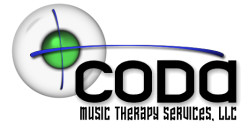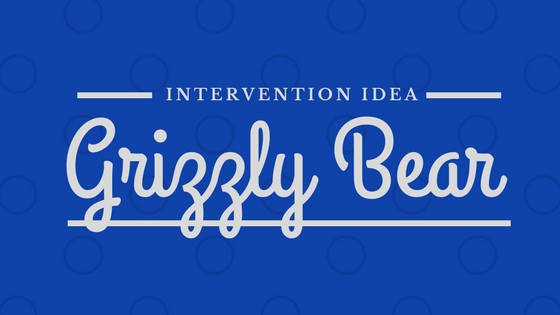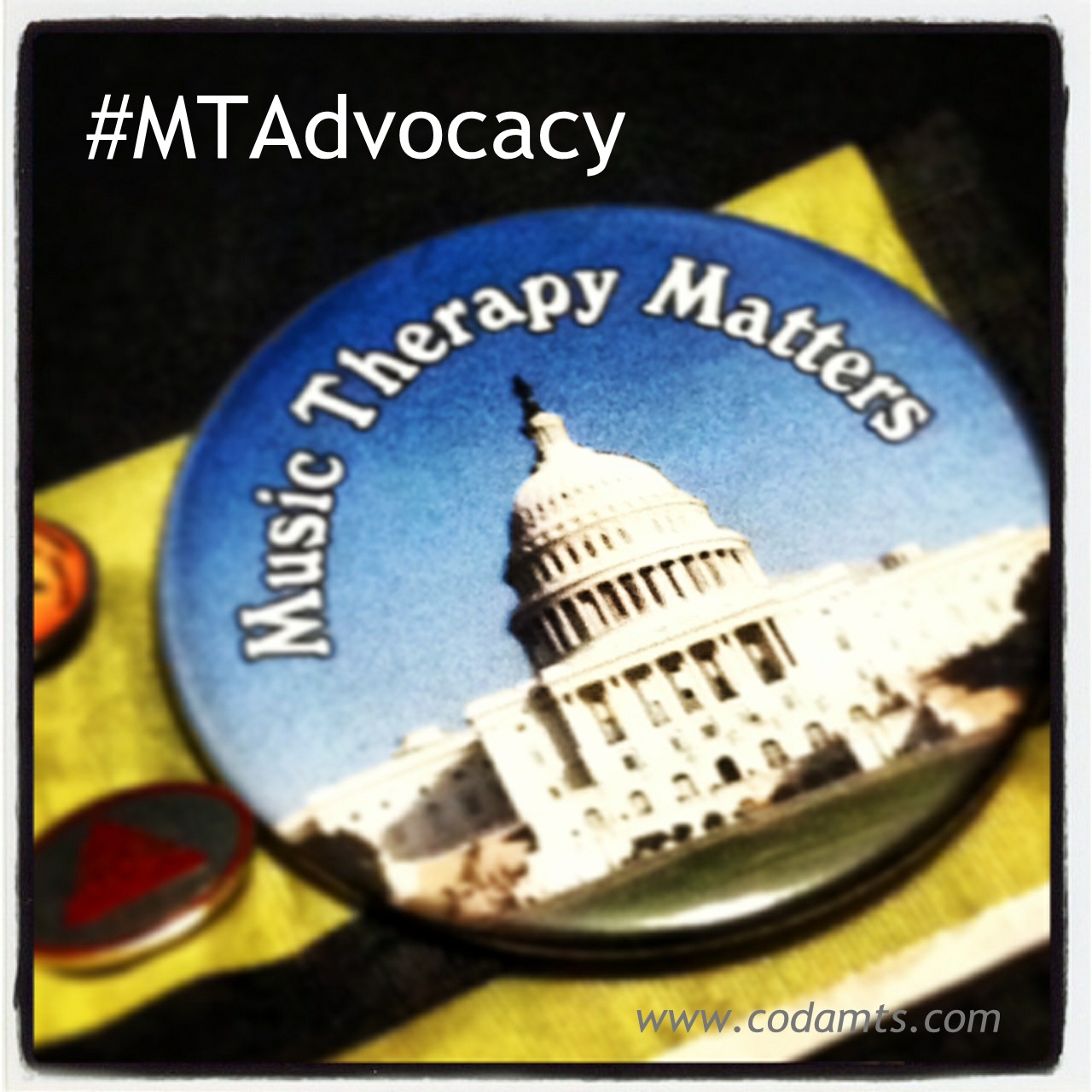We are looking for a board certified music therapist to join our team in September 2018. This is currently a part-time position providing music therapy services to older adults. Potential for position to increase to full-time. View the full posting below. Contact Kellee Hansen (kellee@codamts.com) with any questions.
Intervention Idea: Grizzly Bear
Music is learned like language. Just as young children need to be immersed in a language-rich environment, a music-rich environment is important for their development. For this reason, one of my goals is to teach parents how to incorporate music play within their home.
While playing with my two year-old son last week, I introduced this song – Grizzly Bear – naturally through our play. He was bouncing on a laundry hamper, making up a song about riding a horse, and he started to call it a “grizzly bear.” I started to sing the song for him and he immediately loved the “ROAR!” at the end!
He was hooked.
He kept asking to sing it again. And again. And again.
After about the fifth repetition, I laid down on the ground and pretended to sleep like the bear. Then he took a turn as the sleeping bear. Then he made a “cave” using some of his toys. A few more repetitions later, my husband came in and added the blanket ceiling for his cave. My son then put his teddy bear in the cave and sang for him!
At this point, I decided I needed to get this on video to share with all of you! So, here is about the fifteenth repetition of Grizzly Bear.
You may have noticed that during the second repetition, while my son was pretending to be the bear, I paused throughout the song. This was done intentionally to target a few specific skills.
Social Skills: First, I was assessing his impulse control and patience. Clearly, he LOVES the roar at the end of the song; I was intentionally delaying gratification to see how he would handle it.
Musical Skills: I was also assessing his ability to maintain tonality. As young children begin to audiate – that is, to hear and comprehend the music internally – they are able to complete musical phrases within the correct tonality. By pausing, I was 1) giving him the opportunity to internalize the music and 2) assess whether he would accurately complete the phrase.
Ready to try this song at home? I would love to hear how it goes! Leave a comment below, send me a Tweet, or message me on Facebook!
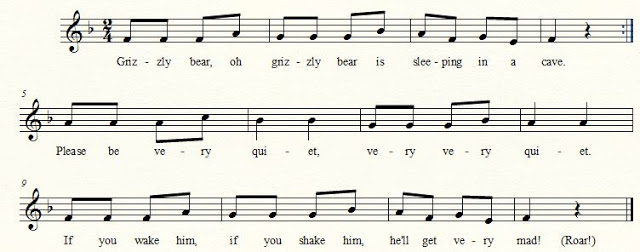 [Note: This is the notation of how the song is traditionally taught. You may notice that I start with a pick-up on the V – C, in the key of F. This is how I learned the song and have always sung it. Choose whichever you prefer!]
[Note: This is the notation of how the song is traditionally taught. You may notice that I start with a pick-up on the V – C, in the key of F. This is how I learned the song and have always sung it. Choose whichever you prefer!]
5 More Years: My Recertification Journey
2016 marked my 10th year as a board-certified music therapist. In keeping with the requirements of the MT-BC credential, this means I had to renew my certification this year. Every five years, music therapists must complete at least 100 hours of continuing education. I ended up having FAR beyond that during this five-year cycle. I know music therapists are often trying to get ideas for continuing education credits, so I thought I would share my continuing education activities from the past five years and how they contributed to my recertification requirement.
Graduate Coursework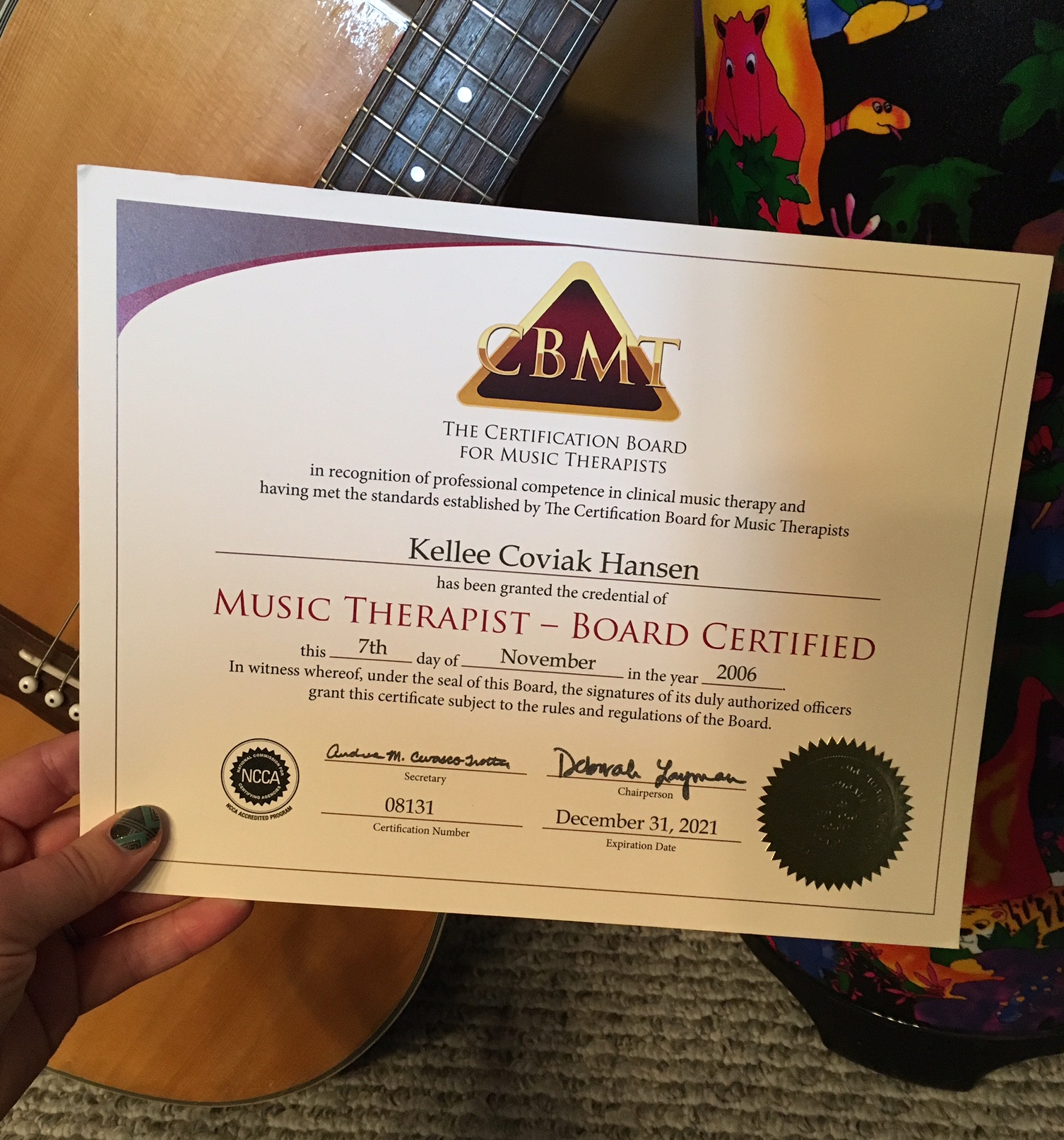
I completed my master’s degree in Special Education from January 2013-December 2015. Consequently, I had enough credits to renew my certification with my graduate courses alone. Ultimately, I had 614 credit hours of graduate coursework, 100 hours of which could be used towards my certification.
Music Therapy Conferences
Music therapists earn 5 CMTE – Continuing Music Therapy Education – credits for attending a national or regional conference. I earned 30 credits for my conference attendance during these five years; 15 of which could be counted towards my recertification.
Educational Courses
There are opportunities to earn additional CMTEs at conferences through participation in workshops of 3 hours or more. Many state organizations (e.g. Michigan Music Therapists) offer workshops throughout the year and some music therapy practices and/or agencies offer courses, as well. It is now also possible to take CMTE courses online and/or via self-study through a number of approved course providers, including courses available for AMTA members on the AMTA website, Music Therapy Ed, and Music Works Publications. I earned a total of 112 credits in this category; a maximum of 100 could be counted towards my recertification.
Professional Development
Preparing and presenting professional experiences for others is included under the Professional Development category. During this five-year cycle, I presented seven different sessions for conferences and/or workshops. (Note: Some presentations were repeated, but they can only be counted for credits the first time that topic is presented.) I earned 80 credits for my professional presentation activities, which is also the maximum number that could be counted towards recertification.
Professional Service
Finally, I earned continuing education for my professional service. This included serving on the executive board of Michigan Music Therapists, serving on the Michigan Task Force, and serving on a committee when Michigan hosted the GLR conference in 2012. Honestly, I have no idea how many hours I have dedicated to these endeavors, but it is far beyond the maximum 20 hours which are allowed towards recertification!
For additional information about music therapy certification/recertification, visit the CBMT website. I highly recommend familiarizing yourself with the Recertification Manual early in your cycle, so you do not find yourself scrambling for credits during the last few months/weeks!
“Directing” the Michigan Task Force: My Race for #MTAdvocacy

In her guest post, Dr. Dena Register describes one of the three roles of music therapy advocacy as the “Directors.” She writes, “Directors are the ones who are able to see the big picture of possibilities that exist beyond the current situation.” I would consider my role in #MTAdvocacy as that of a director.
I clearly remember sitting at the 2012 AMTA national conference and seeing a slew of my colleagues receiving the “Changemaker Award for Music Therapy Advocacy,” as they had successfully spearheaded licensure legislation within their states. I remember turning to Bernadette – my music therapy partner-in-crime and task force co-chair – and saying we needed to get the licensure efforts started in Michigan. Over three years later, we have the wheels in motion, but we are still far from licensure legislation in Michigan.
One of the biggest and most important lessons that I have learned through the task force process is that advocacy is a marathon, not a sprint.
The first step in the task force process was to gather our team. We connected with a number of Michigan music therapists representing work within a variety of populations. We examined current Michigan legislation which may relate to our work as music therapists. Then we set out to gain a more complete picture of music therapy in Michigan by drafting and distributing a survey to the nearly 200 Michigan music therapists. We then assembled this information into a Fact Sheet on Michigan music therapy.
At this point, our progress encountered a big delay, as it became time for the 2014 elections. There was a lot of turnover in our state legislature and both the house and the senate assumed a Republican majority. This caused us to have to change our focus a bit and re-evaluate our best options for pursuing “advocacy champions” within the legislature.
In the spring of 2015, the Michigan task force held an advocacy training for Michigan music therapists and our first Hill Day on April 22, during Michigan Music Therapy Week. We had 9 music therapists in attendance and we met with 12 separate legislators and/or their staff. Unfortunately, I was not able to meet with my Representative, Tom Barrett, as he was tied up in committee hearings concerning the auto no-fault legislation.
Another lesson I’ve learned through this process is that there are a lot of factors which are outside of our control. At the time of our Hill Day, auto no-fault was a matter of priority. Now, our government is – understandably – focused on fixing the Flint water crisis. When those bigger issues arise, we really just have to sit back and wait for the right time to continue our journey. Through it all, we keep lacing up our shoes with our sights set on the finish line: state recognition of music therapy in Michigan.

[Guest Post] Social Media Advocacy Month 2016
The following is a guest post written by Dr. Dena Register, CBMT Regulatory Affairs Advisor, writing on behalf of Music Therapy Social Media Advocacy Month.
Each New Year brings the opportunity to reflect on all that we have accomplished and to determine what is needed in the coming year to move forward. As the Regulatory Affairs (CBMT) and Government Relations (AMTA) teams reflect on the first 10 years of the State Recognition Operational Plan, we are grateful for the number of individuals that have actively engaged in the advocacy process. We have had the incredible fortune to watch groups of diverse individuals pull together, capitalize on their strengths, and create access to services for clients and families that benefit greatly from music therapy.
One of the observations we reflect on regularly is what makes an advocacy team successful. The teams that stand out are those that have 3 different kinds of participants: Connectors, Reflectors and Directors. While this is certainly not an exhaustive list, this seems to be a “triple threat” of action-oriented personalities that are able to work in tandem and move a group forward.
Building Bridges

“Connectors” are people who are gifted at building bridges by bringing others together and recognizing complimentary skill sets in those that they know. Connectors enjoy creating opportunities for people from diverse background and experiences to meet and interact. The role of the Connector in advocacy is to maximize the human resources available to them and to increase the network for their cause by helping interested parties get to know one another and discuss common interests. It is often the Connectors who are able to establish relationships with legislators or other decision makers that develops them into incredible advocates.
Holding Up the Mirror

“Reflectors” are gifted at taking in information, experiences, and perceptions and—as the name implies—reflecting back the most salient points to those around them. Reflectors often have a knack for diffusing situations by indicating an understanding and empathy for someone else’s position. Reflectors also make great advocates because of their fierce loyalty to their cause. Their ability to see issues from multiple perspectives and then to communicate that to multiple audiences brings all sides of an issue to the foreground for discussion. Reflectors unite various individuals and guide the group to a vision that recognizes the complexity of all issues.
Consulting the Compass

“Directors” are the ones who are able to see the big picture of possibilities that exist beyond the current situation. They are able to assimilate the work of the “Reflectors” and the “Connectors” and navigate a course of next steps based on that information. Directors also gather additional relevant information as they move forward and constantly attend to what course corrections are necessary to get to their end goal. Those who are most successful in this role demonstrate flexibility in their thinking and actions, which allows them to accommodate to various situations that are presented and that often change without prior notice. Directors take a broad view of an issue, projecting out beyond it’s current status or challenge and using an ideal vision or end goal to guide the day-to-day steps necessary to get there.
So how about you? Are you a Connector, Reflector or Director? Or maybe there is another description you would use?
Music Therapy in Michigan Week 2014
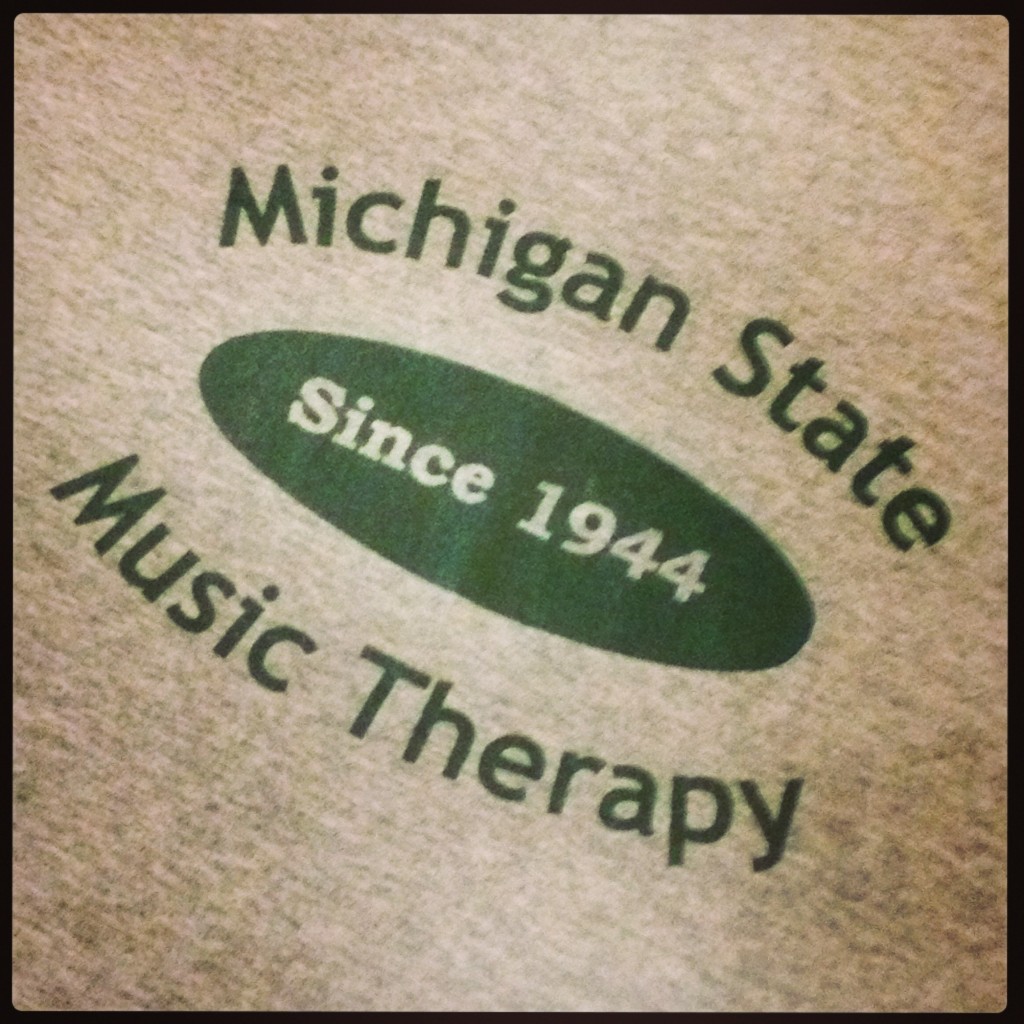
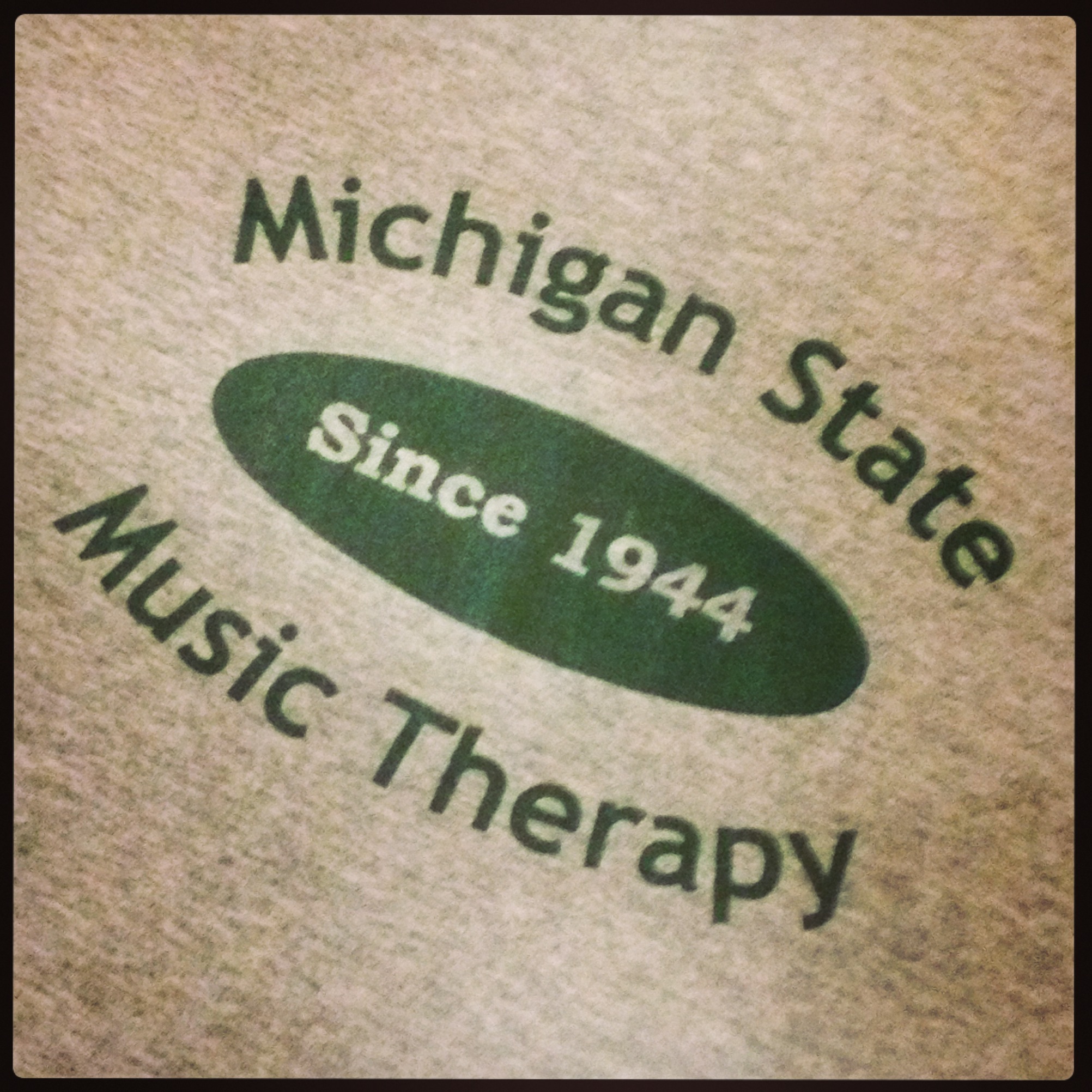
I am proud to be an alumna of this program.
Today I am wearing one of my favorite music therapy t-shirts: my MSU MT shirt. I actually designed this shirt, which was sold by the MSU Music Therapy Club while I was a student. Though it is not uncommon to see me in a music therapy shirt (especially on a Friday), this week it is particularly noteworthy because it is the final day of Music Therapy in Michigan Week!
The last full week in April is always Music Therapy in Michigan Week. This is a time to celebrate, educate, and advocate for music therapy services within Michigan. This is an especially exciting time for music therapy advocacy in Michigan, as the state task force (of which I am a co-chair) is in full swing. The task force recently unveiled a fact sheet based on the results of a survey of music therapists we conducted last fall. Also, there have recently been a number of new music therapy job listings within the state.
How are you celebrating #MTinMIweek2014? Leave a comment below!
A bit more about the task force…
The purpose of the task force is to examine music therapy within Michigan, particularly in regards to our state government. Board certified music therapists are credentialed by an independent national certification board (CBMT), but each state government considers the MT-BC credential differently. Currently, the Michigan state government does not have a form of title protection for music therapists, so there is no repercussion if a non-credentialed individual calls him or herself a music therapist. We want to be sure that individuals who are seeking music therapy treatment receive quality, evidence-based services from someone who is properly trained to provide them. All CODA MTS music therapists are board certified and actively maintain their credential through continuing education experiences. Wondering more about the process to become board certified? The American Music Therapy Association website provides all those details here.
We Are…Educated!
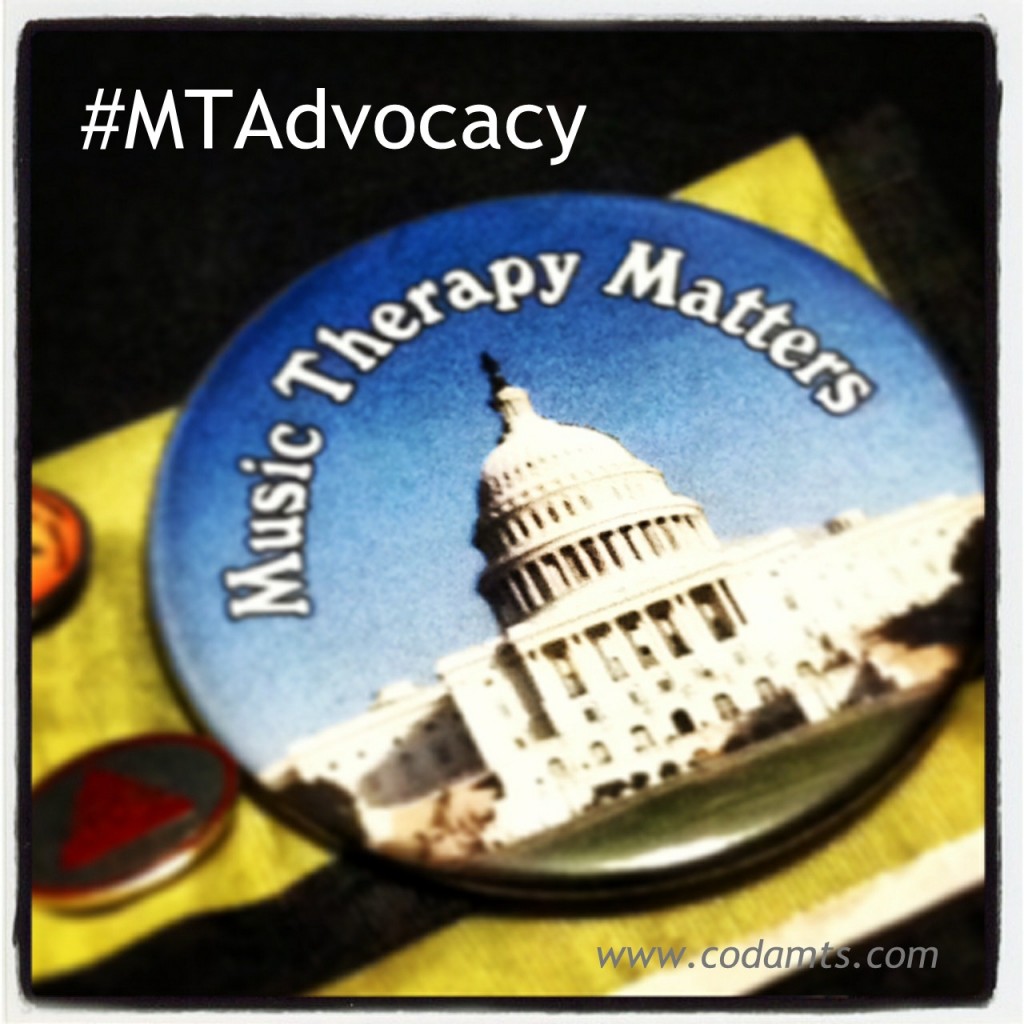
The 2014 Social Media Music Therapy Advocacy Month (#MTAdvocacy) theme is “We are…”. This theme is intended to “center on exploring and honoring the profession of music therapy as a distinct profession, unique from other professions and professionals with which we work” (American Music Therapy Association). Though it has taken me ALL MONTH to get around to putting my thoughts into words (yes, it has been a whirlwind of a month!), I have spent a lot of time reflecting on this theme. An advocacy aspect which is particularly relevant in my life right now is the amount of education music therapists have and how surprised many people are when they find out what is involved in becoming a board-certified music therapist.
There are three main steps to initially becoming a board-certified music therapist: 1) complete an approved music therapy training program (a 4-year undergraduate degree or a 2-year equivalency program for those who already have a degree in music); 2) complete a six-month music therapy internship; and 3) successfully pass the music therapy certification exam. An individual may then use the credential: MT-BC, meaning Music Therapist Board Certified. [Note: There are other credentials used in other countries, as well as fully trained individuals who obtained a Registered Music Therapist (RMT) credential prior to the establishment of the MT-BC.]
Once certified, the music therapy certification cycle is five years. At the end of each cycle, the music therapist must either take a recertification exam or provide documentation that he/she has completed at least 100 hours worth of continuing music therapy education (CMTE) credits within the five-year cycle. The CBMT Scope of Practice outlines the skills board-certified music therapists are trained to perform and we adhere to a Code of Professional Practice.
Music therapists are not only trained to be proficient musicians – taking courses in theory, aural training, music history, and performance classes – but we also take courses in biology, anatomy, medical terminology, special education, psychology and/or counseling. Many music therapists pursue graduate and doctoral degrees in music therapy or a related field. For example, I am currently completing my master’s in Special Education with an emphasis in Early Childhood Special Education, as these are populations with whom I extensively work.
Unfortunately, there are still many who do not understand the requirements for music therapy certification. I recently heard about an individual who was employed as a “music therapist” for six years and had absolutely no music therapy training. Both employers and consumers need to be aware of the qualifications of anyone providing their services. Many states, including Michigan, are in the process of examining and/or actively pursuing state recognition of music therapy through licensure or title protection, to help ensure that quality services are being provided.
To learn more about music therapy training and schools offering music therapy programs, please visit the American Music Therapy Association or post your questions below.
#MTAdvocacy Month 2014: Guest Post from Judy Simpson
The theme for this year’s Social Media Advocacy Month is “We Are…”. The following is a guest post from Judy Simpson, MT-BC, Director of Government Relations at the American Music Therapy Association.
“We are…MUSIC THERAPISTS!”
Judy Simpson, MT-BC
When I started my career as a music therapist in 1983, it was not uncommon for me to describe my profession by comparing it to other professions which were more well-known. If people gave me a puzzled look after I proudly stated, “I use music to change behaviors,” I would add, “Music therapy is like physical therapy and occupational therapy, but we use music as the tool to help our patients.” Over the years as I gained more knowledge and experience, I obviously made changes and improvements to my response when asked, “What is music therapy?” My enhanced explanations took into consideration not only the audience but also growth of the profession and progress made in a variety of research and clinical practice areas.
The best revisions to my description of music therapy, however, have grown out of government relations and advocacy work. The need to clearly define the profession for state legislators and state agency officials as part of the AMTA and CBMT State Recognition Operational Plan has forced a serious review of the language we use to describe music therapy. The process of seeking legislative and regulatory recognition of the profession and national credential provides an exceptional opportunity to finally be specific about who we are and what we do as music therapists.
For far too long we have tried to fit music therapy into a pre-existing description of professions that address similar treatment needs. What we need to do is provide a clear, distinct, and very specific narrative of music therapy so that all stakeholders and decision-makers “get it.” Included below are a few initial examples that support our efforts in defining music therapy separate from our peers that work in other healthcare and education professions.
- Music therapist’s qualifications are unique due to the requirements to be a professionally trained musician in addition to training and clinical experience in practical applications of biology, anatomy, psychology, and the social and behavioral sciences.
- Music therapists actively create, apply, and manipulate various music elements through live, improvised, adapted, individualized, or recorded music to address physical, emotional, cognitive, and social needs of individuals of all ages.
- Music therapists structure the use of both instrumental and vocal music strategies to facilitate change and to assist clients achieve functional outcomes related to health and education needs.
- In contrast, when OTs, Audiologists, and SLPs report using music as a part of treatment, it involves specific, isolated techniques within a pre-determined protocol, using one pre-arranged aspect of music to address specific and limited issues. This differs from music therapists’ qualifications to provide interventions that utilize all music elements in real-time to address issues across multiple developmental domains concurrently.
As we “celebrate” 2014’s Social Media Advocacy Month, I invite you to join us in the acknowledgement of music therapy as a unique profession. Focused on the ultimate goal of improved state recognition with increased awareness of benefits and increased access to services, we have an exciting adventure ahead of us. Please join us on this advocacy journey as we proudly declare, “We are Music Therapists!”
About the Author: Judy Simpson is the Director of Government Relations for the American Music Therapy Association. She can be reached at simpson@musictherapy.org.
#MTAdvocacy in Michigan
January is Music Therapy Social Media Advocacy month and the theme for 2013 is CONNECT. This event was created to celebrate music therapy and advocate throughout social media avenues. During this past year, I became the Public Relations chair for the Michigan Music Therapists organization. So, for my contribution to the #MTAdvocacy cause and in light of my new role, I decided to focus on the connections music therapy has made with local media in recent years. Here are some articles, interviews, videos, etc. you may want to check out.
June 23, 2011 – A Love Song in Three-Part Harmony tells the story of Louie Morand’s work at the Kalamazoo County Juvenile Home.
March 22, 2012 – Music Therapy Proving Beneficial in Brain Injury Response is an article about Erin Wegener’s work in neurologic music therapy within Spectrum Health.
Sept. 17, 2012 – Eastern Michigan University professor, Dr. Terra Merrill, discussed music therapy on Michigan Radio. Listen to her interview here.
Oct. 1, 2012 – Another interview & brief article featuring Dr. Terra Merrill on Everything Elderly, a weekly show on 1290 WLBY (Ann Arbor, MI): Music Therapy Offers a Wealth of Significant Benefits.
Oct. 31, 2012 – This is a nice article about Michigan Music Therapist, Rebecca Findley, being selected as the GLR’s first VP-Elect: Great Lakes Caring Hospice Music Therapist Voted VP-Elect of AMTA Great Lakes Region.
Dec 31, 2012 – This article actually came out of Minneapolis, MN, but was posted by Northern Michigan’s 9 & 10 News: MindStart Brings Music Therapy DVDs to Dementia Care.
And, finally, a video that is very near and dear to my heart, A Music Therapy Documentary: Thank You for the Music, which tells the story of the moratorium placed on the MSU Music Therapy program in 2009.
Do you know of other recent Michigan music therapy features? Please share them in the comments below!
Setting S.M.A.R.T. Music Therapy Goals
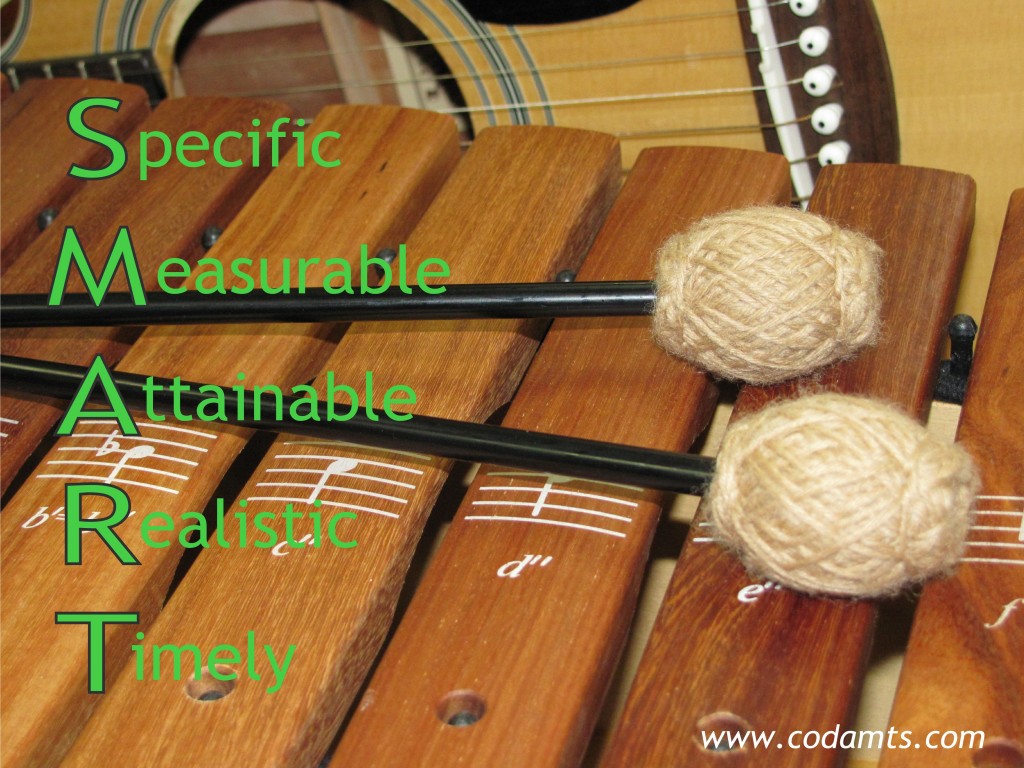
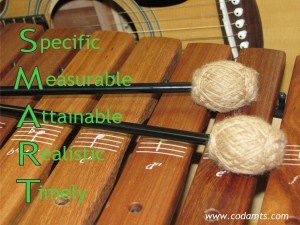 As the new year begins, many people set about making resolutions. On multiple instances, I’ve heard reference to setting S.M.A.R.T. goals. That is, goals that are Specific, Measurable, Attainable, Realistic, and Timely. Not only is this a great way of thinking about resolution goals, but this is an effective technique for setting music therapy goals.
As the new year begins, many people set about making resolutions. On multiple instances, I’ve heard reference to setting S.M.A.R.T. goals. That is, goals that are Specific, Measurable, Attainable, Realistic, and Timely. Not only is this a great way of thinking about resolution goals, but this is an effective technique for setting music therapy goals.
Specific
When drafting music therapy goals, music therapists usually start with a general goal area, but have very specific objectives. For example, a goal may be to improve communication and an objective for that goal is that the client will respond to yes or no questions.
Measurable
Music therapy is an evidence-based practice, meaning we use data to support effective techniques. Therefore, it is important that we are able to collect objective data to determine whether or not a goal has been achieved. To determine if a goal is measurable, we consider whether it answers the questions of “How many?”, “How much?”, “How long?”, and/or “How will I know it is accomplished?” In regards to the previous example, the music therapist may choose to measure the number of times the client responds to a yes or no question, whether or not prompts are given in order for the client to complete the objective, how many prompts are needed, what types of prompts are given, etc.
Attainable & Realistic
I fully believe in maintaining high expectations for my clients and placing absolutely no limitations on what they may achieve. Nothing makes me happier than seeing a client exceed my original goals for him or her! At the same time, it is important to structure a treatment plan with which he or she can be successful. Returning to my example of responding to yes or no questions, it is possible that this could be a goal for quite a few different clients with a wide variety of strengths and deficits. However, while I may be looking for an unprompted verbal response from one client, that same objective may be successfully achieved by another client through a physically prompted response using an Augmentative and Alternative Communication (AAC) device.
Timely
With every treatment plan, it is imperative that there is a specified date for achieving the goal and/or reviewing progress towards the goal. By specifying a deadline, there is an added aspect of accountability and a determined point for evaluating whether the current treatment is acceptable or if treatment objectives need to be reconsidered. Most of my clients are in special education and have an Individualized Education Program (IEP) in place; by law, IEPs must be reviewed annually. However, it is possible that a music therapy goal may need to be reviewed semi-annually, quarterly, and occasionally even monthly if the client is quickly progressing or regressing.
Have you set any S.M.A.R.T. goals for yourself this year? Leave a comment below to tell us about your plan for a successful 2013!
